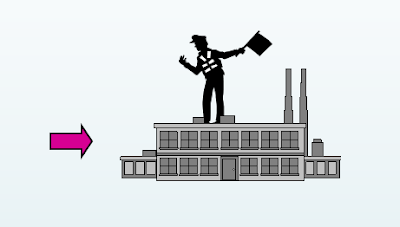Just in time (JIT)
To have only the right materials, parts & products in
the right place at the right time
- Only what is needed, nothing more
- Continual improvement & a pull system
- Smaller inventories & Improved quality
- Shorter lead times & Lower production costs
- Reduced space requirements- Shorter lead times & Lower production costs
- Increased productivity
- Greater flexibility
Misconceptions
- Only an inventory control system
- A method to “Push” inventory back to the supplier
- A quality control program
Elements of JIT Manufacturing
- Inventory reduction exposes problems
- Kanban & pull production systems
- Small lots & quick setups
- Uniform plant loading
- Flexible resources
- Efficient facility layouts
Role of Inventory Reduction
- Inventory = Lead Time (less is better).
- Inventory hides problems.
- Reducing the level of inventory (water) allows management (the ship) to see the problems in the operation (the rocks) & work to reduce them.
Push/Pull production systems
Push Systems
Schedule work releases based on demand
(make to stock)
- Production oriented
- Inherently due-date driven
- Control release rate, observe WIP level
Pull Systems
Authorize work releases based on system
status (make to order)
- Customer oriented
- Inherently rate driven
- Control WIP level, observe throughput
Push/pull interface
- Make-to-stock & make-to-order can be used in same system
- Dividing point is called the inventory-order interface or push-pull interface
- Eliminate entire portion of cycle time seen by customers by building to stock
Advantages of Pull Systems
- Low Unit Cost (low inventory, reduced space, little rework)
- High External Quality (high internal quality, pressure for good quality, promotion of good quality)
- Good Customer Service (short cycle times, steady & predictable output stream)
- Flexibility (avoids committing jobs too early, encourages floating capacity)
Implementing Pull
- Pull is Rigid (replenishing stocks quickly (just in time) requires level mix, volume, sequence)
- Support Rigidity (production smoothing/mix stabilization)
- Mitigate Rigidity in Production System (capacity buffers, setup reduction, flexible labor, facility layout, product design)
- Mitigate Rigidity in Organization (TQM, vendor management)
Small Lot Sizes & Quick Setups
- Small lots mean less average inventory & shorten manufacturing lead time
- Small lots with shorter setup time increase flexibility to respond to demand change
- Strive for single digit setups < 10 minutes (SMED)
- Ultimate goal is single unit lot sizes
Flexible Resources
- Movable, general purpose equipment
- Portable equipment with plug in power/air
- Capable of being setup to do many different things with minimal setup time
- Multi-functional workers
- Workers assume considerable responsibility
- Cross-trained to perform several different duties
- Trained to also be problem solvers
Effective Facility Layouts
- Workstations in close physical proximity to reduce transport & movement
- Streamlined flow of material
- Often use
- Cellular Manufacturing or ‘U’ shaped lines
Implementing JIT
- Starts with a company shared vision of where it is & where it wants to go
- Management needs to create the right atmosphere & designated “Champion”
- Implement the sequence of following steps
- Make quality improvements, Reorganize workplace & Reduce setup times
- Reduce lot sizes & lead times
- Implement layout changes
- Switch to pull production
- Develop relationship with suppliers




No comments:
Post a Comment